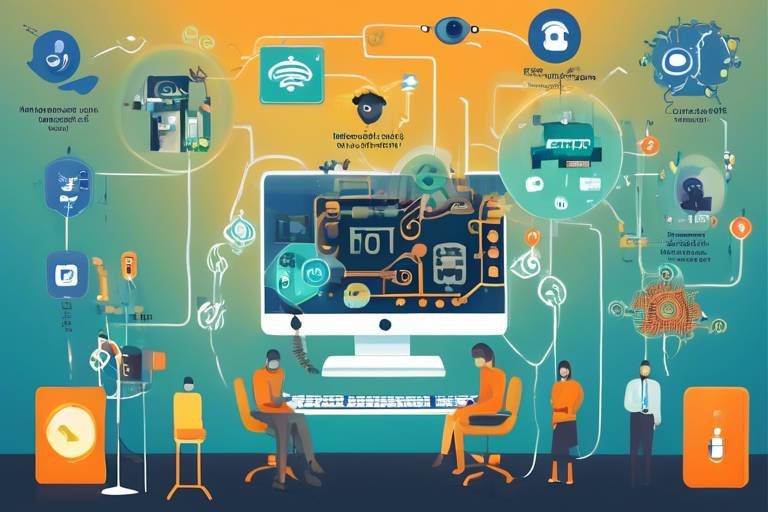The Human Factor in Cybersecurity
In today's digital landscape, where technology is advancing at breakneck speed, the phrase "the weakest link in cybersecurity is often the human element" rings truer than ever. While organizations invest heavily in firewalls, antivirus software, and intrusion detection systems, they often overlook the critical role that human behavior plays in maintaining security. Cybersecurity is not just a technical issue; it’s a people problem. This article delves into the intricate relationship between human behavior and cybersecurity, emphasizing the importance of awareness, training, and a strong organizational culture in combating cyber threats.
Imagine a fortress with the most advanced defenses, yet its gates are left unguarded because the sentinels are distracted or uninformed. This analogy perfectly encapsulates the current state of many organizations. Cybercriminals are increasingly targeting the human factor, exploiting vulnerabilities like social engineering, phishing, and insider threats. To effectively protect sensitive data and systems, organizations must recognize that their employees are both the first line of defense and a potential vulnerability. By fostering a culture of security awareness and continuous learning, businesses can significantly enhance their resilience against cyber threats.
Every day, organizations face a multitude of cybersecurity threats that can lead to devastating consequences. From ransomware attacks that lock down critical data to phishing scams that trick employees into revealing sensitive information, the risks are both varied and evolving. It’s essential for organizations to understand these threats, but equally important is recognizing the human vulnerabilities that can lead to breaches and attacks.
Consider the following common cybersecurity threats:
- Phishing: Deceptive emails designed to trick employees into providing sensitive information.
- Malware: Malicious software that can infiltrate systems and compromise data integrity.
- Insider Threats: Employees intentionally or unintentionally causing harm to the organization.
- Social Engineering: Manipulating individuals into divulging confidential information.
By understanding these risks, organizations can tailor their training and awareness programs to address specific vulnerabilities, ultimately fortifying their defenses against cyber threats.
Employee training is not just a checkbox to tick off; it is a vital component in cultivating a security-aware culture within an organization. When employees are educated about potential threats and best practices, they become more vigilant and proactive in their roles. Effective training can drastically reduce human errors, which are often the gateways for cybercriminals.
There are several training methods that organizations can implement to address specific vulnerabilities. For instance, phishing simulations allow employees to experience real-life scenarios in a controlled environment, helping them recognize and respond to potential threats. Security awareness workshops can also provide valuable insights into the latest cyber threats and how to mitigate them.
One innovative approach to training is gamification. By incorporating game-like elements into training programs, organizations can enhance engagement and motivation. Employees are more likely to retain information when they are actively participating in the learning process. Think of it as turning learning into a fun challenge, where employees earn points or badges for completing modules or successfully identifying phishing attempts.
The cybersecurity landscape is constantly changing, making it essential for organizations to prioritize continuous learning. Regular updates and refresher courses ensure that employees remain informed about the latest threats and best practices. This ongoing education helps to create a resilient workforce that can adapt to new challenges as they arise.
Evaluating the success of training initiatives is crucial. Organizations should employ various metrics to assess employee knowledge and behavior changes post-training. This might include pre- and post-training assessments, tracking the number of reported phishing attempts, or monitoring compliance with security protocols. By measuring training effectiveness, organizations can refine their programs and ensure they are making a tangible impact on cybersecurity awareness.
A strong security culture is the backbone of effective cybersecurity. It’s not enough to have policies in place; organizations must embed security into their ethos and encourage proactive behaviors among employees. This cultural shift requires commitment from all levels of the organization.
Leadership plays a pivotal role in fostering a security-first culture. When leaders prioritize cybersecurity and model appropriate behaviors, employees are more likely to follow suit. It’s about creating an environment where security is seen as everyone’s responsibility, not just the IT department’s.
Engaging employees in cybersecurity efforts is vital for creating a robust security culture. Organizations can involve staff in security practices through regular communication, incentives for reporting suspicious activities, and team-building exercises focused on cybersecurity. By making employees active participants rather than passive observers, organizations can significantly enhance their security posture.
- Why is human behavior a critical factor in cybersecurity? Human behavior can either strengthen or weaken an organization’s cybersecurity defenses. Employees are often the target of cyber attacks, and their actions can inadvertently lead to breaches.
- What are effective training methods for employees? Effective training methods include phishing simulations, security awareness workshops, and gamified training programs.
- How can organizations measure the effectiveness of their training? Organizations can measure effectiveness through assessments, tracking reported incidents, and monitoring compliance with security protocols.

Understanding Cybersecurity Risks
In today's digital landscape, the term cybersecurity is thrown around a lot, but what does it really mean for organizations? Simply put, cybersecurity encompasses the practices and technologies designed to protect systems, networks, and data from cyber threats. However, what many people overlook is the critical role that human behavior plays in this equation. The reality is that even the most advanced security systems can be compromised if individuals within an organization are not aware of the risks or fail to follow security protocols.
Organizations today face a myriad of cybersecurity threats, each with its own unique characteristics and potential impacts. From phishing attacks that trick employees into divulging sensitive information to ransomware that can cripple operations overnight, the landscape is constantly evolving. Did you know that according to recent studies, human error is responsible for approximately 95% of cybersecurity breaches? This statistic alone highlights the significance of understanding human vulnerabilities that can lead to security incidents.
One of the most common threats organizations face is the insider threat, which can occur when employees intentionally or unintentionally compromise security. This could be as simple as clicking on a malicious link in an email or as complex as an employee stealing sensitive data for personal gain. In either case, the human factor is at play, and recognizing these vulnerabilities is the first step in mitigating risks.
Moreover, we cannot ignore the impact of social engineering tactics that exploit human psychology. Attackers often manipulate individuals into breaking security protocols, making it essential for organizations to not only implement technology solutions but also foster a culture of security awareness. This means empowering employees to recognize potential threats and take proactive measures to protect themselves and the organization.
As we delve deeper into the world of cybersecurity risks, it becomes clear that awareness and training are paramount. The question is, how can organizations effectively educate their employees about these risks? By understanding the types of threats they face and the human behaviors that contribute to them, organizations can take significant strides towards enhancing their cybersecurity posture.
In summary, understanding cybersecurity risks is not just about technology; it’s about people. Organizations must prioritize awareness and training to ensure that their employees are not just passive recipients of information but active participants in the security process. By doing so, they can significantly reduce the likelihood of breaches and create a more resilient organizational culture.

The Role of Employee Training
In today’s digital landscape, where cyber threats lurk at every corner, the significance of employee training cannot be overstated. It’s not just about installing the latest security software or having a robust firewall; it’s about empowering your workforce with the knowledge and skills they need to recognize and respond to potential threats. Think of your employees as the front line of defense against cyber attacks. If they are well-trained, they can spot a phishing email from a mile away, or identify suspicious activity before it escalates into a full-blown breach.
Effective training programs are designed to foster a security-aware culture within the organization. This involves not only educating employees about the technical aspects of cybersecurity but also instilling a sense of responsibility and vigilance. When employees understand that they play a crucial role in safeguarding sensitive data, they are more likely to take cybersecurity seriously. This proactive approach can significantly reduce human errors that often lead to breaches.
Moreover, the training should be engaging and relevant. Traditional methods of training, such as lengthy presentations or dry manuals, often fail to capture attention. Instead, organizations should utilize interactive training methods that resonate with employees. This could include simulations of real-world scenarios, hands-on workshops, and even gamified learning experiences that make the process enjoyable. By making training interactive, employees are more likely to absorb the information and apply it in their daily tasks.
There are several types of training programs that organizations can implement to address specific vulnerabilities. Some of the most effective include:
- Phishing Simulations: These simulate real phishing attacks to help employees recognize fraudulent emails and links.
- Security Awareness Workshops: These are interactive sessions that cover various aspects of cybersecurity, including password management, data protection, and safe browsing practices.
- Incident Response Drills: These drills prepare employees on how to respond in case of a security incident, ensuring they know the correct steps to take.
By tailoring training programs to the specific needs and vulnerabilities of the organization, companies can create a more resilient workforce that is better equipped to handle potential cyber threats. It’s not just about checking off a box; it’s about creating a culture of security that permeates throughout the organization.
One innovative approach that has gained traction in recent years is the use of gamification in training programs. By incorporating game-like elements such as points, badges, and leaderboards, organizations can increase engagement and motivation among employees. Imagine a training program where employees earn points for completing modules or for successfully identifying phishing attempts in simulated environments. This not only makes learning more enjoyable but also fosters a sense of competition and camaraderie among staff.
Gamification can transform mundane training sessions into exciting challenges, ultimately leading to better retention of information and improved performance in real-world scenarios. When employees are excited about learning, they are more likely to participate actively and absorb crucial information that can protect the organization.
Cyber threats are not static; they evolve rapidly. Therefore, continuous learning is essential. Organizations should implement regular updates and refresher courses to keep employees informed about the latest threats and best practices. This could include monthly newsletters, quarterly workshops, or even annual cybersecurity conferences.
It's important to remember that training is not a one-time event but an ongoing process. By fostering a culture of continuous learning, organizations can ensure that their employees remain vigilant and informed about the ever-changing landscape of cybersecurity.
Finally, evaluating the success of training initiatives is crucial. Organizations should establish metrics and methods for assessing employee knowledge and behavior changes post-training. This could include quizzes, feedback surveys, and monitoring the number of reported phishing attempts or security incidents before and after training sessions. By measuring effectiveness, organizations can refine their training programs and ensure they are meeting their goals.
In conclusion, employee training is a vital component of any cybersecurity strategy. By investing in comprehensive, engaging, and continuous training programs, organizations can significantly enhance their resilience against cyber threats and create a culture where security is a shared responsibility.
Q: Why is employee training important in cybersecurity?
Employee training is crucial because human error is often the weakest link in cybersecurity. Well-trained employees can recognize threats and take appropriate actions to mitigate risks.
Q: What types of training programs are most effective?
Effective training programs include phishing simulations, security awareness workshops, and incident response drills, tailored to the organization’s specific needs.
Q: How can gamification enhance training?
Gamification increases engagement and motivation by incorporating game-like elements into training programs, making learning enjoyable and effective.
Q: How often should training be updated?
Training should be continuous, with regular updates and refresher courses to keep employees informed about the latest cybersecurity threats and best practices.

Types of Training Programs
When it comes to cybersecurity, one size does not fit all. Different organizations face unique challenges, and thus, the they implement must be tailored to address specific vulnerabilities. The goal is to create a training environment that resonates with employees, making them more aware of the potential threats lurking in the digital shadows. Let’s explore some effective training programs that can significantly enhance an organization’s security posture.
One of the most prevalent and effective training methods is the phishing simulation. This approach involves sending simulated phishing emails to employees to test their ability to recognize and respond to such threats. By creating a safe environment where employees can learn from their mistakes, organizations can effectively gauge their readiness against real-world phishing attacks. These simulations not only raise awareness but also provide immediate feedback, allowing employees to understand what to look for in suspicious emails.
Another valuable training approach is security awareness workshops. These workshops can be interactive sessions where employees engage in discussions about real-world cybersecurity incidents. They can share experiences and learn from one another, fostering a community of vigilance. By incorporating real-life examples, these workshops make the abstract concepts of cybersecurity more tangible and relatable. Employees are more likely to remember and apply what they learn when it’s connected to a real story.
In recent years, gamification has emerged as a powerful tool in the realm of cybersecurity training. By integrating game-like elements into training programs, organizations can significantly boost engagement levels. Imagine learning about cybersecurity through fun quizzes, challenges, and rewards! This approach not only makes learning enjoyable but also encourages healthy competition among employees, motivating them to absorb critical information. Gamification transforms the training experience from a mundane task into an exciting adventure.
However, it’s crucial to recognize that cybersecurity threats are constantly evolving. Therefore, continuous learning and regular updates are essential. Organizations should implement refresher courses and provide ongoing training opportunities to keep employees informed about the latest threats and security practices. This ensures that the knowledge gained is not just a one-time event but a continuous journey towards becoming more security-conscious. Regular training updates can be delivered through various formats, including online modules, webinars, and even short, engaging videos.
Ultimately, the effectiveness of these training programs can be measured through various metrics. Organizations should assess employee performance before and after training sessions to determine knowledge retention and behavioral changes. Surveys, quizzes, and even direct observation can provide insights into how well employees are applying what they’ve learned in their daily routines. By continuously evaluating the effectiveness of training initiatives, organizations can refine their approaches and ensure that they are equipping their workforce with the necessary tools to combat cyber threats.

Gamification in Training
In today's fast-paced digital landscape, traditional training methods often fall short when it comes to engaging employees. That's where gamification steps in, transforming the mundane into the exciting. By incorporating game-like elements into cybersecurity training, organizations can significantly enhance employee engagement and retention of crucial information. Imagine turning a dry lecture about phishing scams into a competitive game where employees earn points for identifying threats correctly. This approach not only makes learning fun but also fosters a deeper understanding of cybersecurity principles.
Gamification taps into the natural human desire for achievement and competition. When employees participate in training programs that include leaderboards, rewards, and badges, they are more likely to actively engage with the material. For instance, organizations can create a series of challenges that mimic real-world scenarios, allowing employees to practice their skills in a safe environment. This hands-on experience is invaluable, as it prepares them to respond effectively to actual cyber threats.
Moreover, gamified training can be tailored to address specific vulnerabilities within an organization. For example, if a company struggles with employees falling for phishing attacks, a targeted game could simulate various phishing attempts, teaching employees how to recognize and avoid them. The interactive nature of these programs encourages learners to think critically and apply their knowledge in practical situations.
To illustrate the effectiveness of gamification in training, consider the following table that outlines key benefits:
| Benefit | Description |
|---|---|
| Increased Engagement | Employees are more likely to participate actively when learning is fun and competitive. |
| Improved Retention | Game-based learning enhances memory retention, making information stick longer. |
| Real-World Application | Simulated scenarios prepare employees for real-life cyber threats, building confidence. |
| Immediate Feedback | Gamification provides instant feedback, allowing employees to learn from mistakes quickly. |
In summary, gamification in cybersecurity training is not just a trend; it's a powerful tool that can reshape how organizations approach employee education. By making learning interactive and enjoyable, companies can cultivate a workforce that is not only aware of cybersecurity risks but also motivated to act against them. As we continue to navigate the complexities of the digital world, embracing innovative training methods like gamification will be essential in building a robust defense against cyber threats.
- What is gamification in training? Gamification involves integrating game-like elements into training programs to enhance engagement and learning outcomes.
- How does gamification improve cybersecurity training? It makes learning interactive and enjoyable, leading to better retention and application of cybersecurity principles.
- Can gamification be tailored to specific threats? Yes, gamified training can be designed to address particular vulnerabilities, such as phishing attacks.
- What are some examples of gamification in training? Examples include leaderboards, rewards systems, and simulation-based challenges that mimic real-world scenarios.

Continuous Learning and Updates
In the ever-evolving landscape of cybersecurity, the notion of continuous learning is not just a luxury; it's a necessity. Cyber threats morph and mutate at a pace that can leave even the most vigilant organizations scrambling to keep up. Imagine trying to catch a moving train while standing still; that’s what it feels like for businesses that fail to prioritize ongoing education in cybersecurity. Regular updates and refresher courses are essential to ensure that employees are not only aware of the latest threats but are also equipped with the tools and knowledge to mitigate them.
One of the most effective ways to implement continuous learning is through a blend of formal training sessions and informal learning opportunities. Companies can create a dynamic learning environment by integrating cybersecurity topics into everyday conversations, newsletters, and team meetings. This approach helps to keep security top-of-mind and encourages employees to share their own experiences and insights regarding potential threats. For example, a simple discussion about a recent phishing attempt can lead to a deeper understanding of how to recognize and report suspicious activity.
Moreover, organizations should leverage technology to facilitate ongoing education. Online platforms that offer bite-sized learning modules can make it easier for employees to stay informed without overwhelming them. A study found that microlearning—short, focused segments of training—can increase retention rates significantly compared to traditional methods. By allowing employees to learn at their own pace, companies can foster a culture of continuous improvement and adaptability.
To illustrate the need for regular updates, consider the following table that outlines the types of cybersecurity threats that have emerged over the past few years:
| Year | Emerging Threats | Recommended Training Focus |
|---|---|---|
| 2021 | Ransomware Attacks | Incident Response Protocols |
| 2022 | Supply Chain Attacks | Vendor Risk Management |
| 2023 | AI-Powered Phishing | Advanced Threat Detection |
In addition to structured training, organizations should also encourage employees to engage with cybersecurity news and updates independently. This can be achieved by providing access to reputable cybersecurity blogs, podcasts, and webinars. When employees take the initiative to learn about emerging threats, they become more adept at recognizing potential risks, leading to a proactive rather than reactive approach to security.
Lastly, it’s crucial to create a feedback loop where employees can share their insights on training effectiveness and suggest improvements. This not only empowers staff but also fosters a sense of ownership over cybersecurity practices. Ultimately, by embracing a culture of continuous learning and updates, organizations can build a robust defense against the ever-present threat of cyberattacks.
- Why is continuous learning important in cybersecurity?
Continuous learning helps employees stay updated on the latest threats and best practices, making them more effective in preventing breaches. - How often should cybersecurity training be conducted?
It's recommended to have regular training sessions, at least quarterly, along with ongoing informal learning opportunities. - What are some effective methods for training employees on cybersecurity?
Methods include interactive workshops, online courses, microlearning, and gamification to keep employees engaged. - How can organizations measure the effectiveness of their training programs?
Organizations can use assessments, feedback surveys, and incident reports to evaluate the impact of their training initiatives.

Measuring Training Effectiveness
When it comes to cybersecurity training, simply conducting a session and calling it a day is far from sufficient. The real question is: how do we know if our training efforts are actually making a difference? Measuring training effectiveness is crucial for understanding whether employees are absorbing the information and applying it in their daily routines. Without proper evaluation, organizations may fall into the trap of assuming compliance, while in reality, vulnerabilities could still lurk beneath the surface.
One effective way to gauge the impact of training is through pre- and post-training assessments. These assessments can take the form of quizzes or practical exercises that test employees' knowledge and skills before and after the training sessions. By comparing the results, organizations can pinpoint improvements and identify areas that may require additional focus. For instance, if a majority of employees struggle with recognizing phishing attempts in the pre-training assessment but show marked improvement afterward, the training can be deemed successful. However, if there’s little to no change, it could indicate that the training methods need reevaluation.
Another method to measure effectiveness is through behavioral observations. This involves monitoring employees' actions in real-time to see if they are applying what they learned. For example, if an employee who previously clicked on suspicious links starts reporting them instead, it’s a clear sign that the training has had a positive effect. This approach not only reinforces the training but also encourages a proactive attitude towards cybersecurity.
Additionally, organizations can utilize incident tracking to assess the effectiveness of training programs. By analyzing the number of security incidents before and after training initiatives, organizations can determine if there’s a significant reduction in breaches or near-misses. This data can be compiled into a table for a clearer visual representation:
| Period | Number of Incidents | Type of Training Conducted |
|---|---|---|
| Before Training | 15 | Basic Cybersecurity Awareness |
| After Training | 5 | Phishing Simulation & Advanced Security Practices |
This table clearly illustrates the decline in incidents, suggesting that the training had a substantial impact. It's essential to keep in mind that the effectiveness of training should not only be measured in numbers but also in the overall culture of security awareness that develops within the organization.
Finally, gathering employee feedback can provide invaluable insights into the training experience. Surveys or informal discussions can reveal how well the training resonated with employees and whether they found the content engaging and relevant. This feedback can guide future training sessions, ensuring they are tailored to meet the needs of the workforce.
In conclusion, measuring training effectiveness in cybersecurity is not a one-size-fits-all approach. It requires a combination of assessments, observations, incident tracking, and feedback to create a comprehensive picture of how well employees are equipped to handle cyber threats. By investing in these measurement strategies, organizations can ensure that their training programs are not only effective but also contribute to a robust security culture.
- How often should cybersecurity training be conducted? It's recommended to conduct training at least once a year, with refresher courses and updates as needed.
- What metrics should be used to measure training effectiveness? Key metrics include pre- and post-training assessments, incident tracking, and employee feedback.
- Can gamification really improve training outcomes? Yes, gamification can enhance engagement and retention of information by making learning more interactive and enjoyable.

Creating a Security-First Culture
When it comes to cybersecurity, the phrase "it takes a village" couldn't be more accurate. Creating a security-first culture within an organization is not just about implementing the latest technology; it’s about weaving security into the very fabric of the workplace. Imagine your organization as a fortress. If the walls are strong but the gates are left open, intruders will find their way in. In the same way, a robust cybersecurity infrastructure can only be effective if every employee understands their role in maintaining it.
To kickstart this transformation, it’s essential to embed security into everyday practices. This means that every decision made, whether it’s about sharing sensitive information or accessing company resources, should be viewed through the lens of security. When employees regularly consider the implications of their actions, they become vigilant guardians of the organization’s assets. But how do you cultivate this mindset? It starts with clear communication from the top down.
Leadership plays a pivotal role in establishing a security-first culture. Leaders should not only advocate for cybersecurity but also model the behaviors they wish to see in their teams. This includes participating in training programs, adhering to security protocols, and openly discussing the importance of cybersecurity in meetings. When employees see their leaders prioritizing security, they’re more likely to follow suit. It’s about creating a ripple effect—the more visible the commitment from leaders, the more it resonates throughout the organization.
Engaging employees in cybersecurity efforts is another vital component. Rather than treating security as a chore, it should be framed as a collective responsibility. Consider implementing initiatives that encourage participation, such as:
- Security Champions: Designate employees from various departments as security champions who can advocate for best practices within their teams.
- Regular Workshops: Host interactive workshops that not only educate but also allow employees to share their experiences and insights regarding cybersecurity.
- Feedback Mechanisms: Create channels for employees to provide feedback on security policies and practices, fostering a sense of ownership and involvement.
Additionally, recognizing and rewarding positive security behaviors can motivate employees to stay vigilant. Whether it’s a shout-out in a company meeting or a small incentive for reporting potential threats, these actions reinforce the idea that security is a shared priority. It’s all about making cybersecurity a part of the organizational narrative, where every employee feels empowered and accountable.
Finally, remember that creating a security-first culture is not a one-time event but a continuous journey. As cyber threats evolve, so must the strategies to combat them. Regularly revisiting and updating security policies, conducting refresher training, and celebrating milestones in security awareness can help keep the momentum going. Just like any successful endeavor, consistency is key. By fostering an environment where security is always top of mind, organizations can significantly enhance their resilience against cyber threats.
Q1: What is a security-first culture?
A security-first culture is an organizational mindset where security is prioritized at every level, and all employees are engaged in maintaining cybersecurity practices.
Q2: How can leadership influence cybersecurity culture?
Leadership can influence cybersecurity culture by modeling security behaviors, prioritizing cybersecurity initiatives, and fostering open communication about security practices.
Q3: What are some effective ways to engage employees in cybersecurity?
Engagement can be achieved through initiatives like security champions, interactive workshops, and recognition programs that reward positive security behaviors.

Leadership's Role in Culture
When it comes to establishing a robust cybersecurity culture, leadership plays a pivotal role that can’t be overstated. Imagine a ship sailing through stormy seas; the captain's decisions determine whether the crew navigates safely or capsizes. In the same vein, leaders within an organization set the tone for how cybersecurity is perceived and prioritized. They are the ones who can either kindle a flame of security awareness or let it flicker out. It’s not just about issuing directives; it’s about embodying the principles of security and making them a core part of the organizational ethos.
Effective leaders understand that cybersecurity is not solely the responsibility of the IT department. Instead, they recognize that every employee, from the front desk to the boardroom, plays a crucial role in safeguarding the organization’s assets. This holistic approach is essential in creating a culture where everyone feels accountable for security. Leaders can foster this sense of responsibility by regularly communicating the importance of cybersecurity, sharing relevant stories, and illustrating the real-world impacts of breaches.
Furthermore, leaders should lead by example. When employees see their managers prioritizing security—whether it’s through compliance with policies, participation in training, or even reporting suspicious emails—they are more likely to follow suit. This behavior sets a precedent and creates an environment where security becomes a shared value. To support this, organizations can implement several strategies:
- Regular Communication: Leaders should consistently discuss cybersecurity in meetings, newsletters, and internal communications to keep it top-of-mind.
- Recognition Programs: Acknowledging employees who demonstrate exemplary security practices can motivate others to follow their lead.
- Open Door Policy: Encouraging employees to voice their concerns or report suspicious activities without fear of repercussions fosters a proactive security environment.
Moreover, investing in leadership training that focuses on cybersecurity awareness can amplify these efforts. Leaders equipped with the right knowledge can better advocate for security initiatives, allocate resources effectively, and inspire their teams. This training should not be a one-time event but rather an ongoing process that evolves alongside the ever-changing threat landscape.
In conclusion, leaders have the unique opportunity to shape a security-first culture within their organizations. By actively engaging in cybersecurity practices, communicating openly, and fostering an environment of accountability, they can turn their teams into vigilant guardians of the organization’s digital assets. After all, in the world of cybersecurity, a united front is the strongest defense against potential threats.

Employee Engagement Strategies
Engaging employees in cybersecurity isn't just a nice-to-have; it's a necessity for building a resilient organization. When employees feel like they're part of the security solution, they become more vigilant and proactive. So, how do you turn passive observers into active participants in your cybersecurity efforts? First, it's essential to make cybersecurity relatable. This can be achieved through storytelling—sharing real-life incidents of breaches and their consequences can bring the abstract risks of cyber threats into sharp focus. When employees see the potential impact on their work, they are more likely to take security seriously.
Another effective strategy is to create a sense of ownership among employees. Encourage them to report suspicious activities, and reward them for doing so. This could be as simple as implementing a “Spot the Phish” program where employees can identify phishing attempts and report them. Recognizing their efforts not only boosts morale but also reinforces the idea that everyone plays a crucial role in maintaining security.
Moreover, fostering a collaborative environment can significantly enhance engagement. Consider forming a cybersecurity task force that includes representatives from different departments. This approach not only diversifies the perspectives on cybersecurity but also helps in creating tailored strategies that resonate with various teams. When employees collaborate on security initiatives, they become more invested in the outcomes, and the culture of vigilance spreads organically.
Additionally, regular communication is key. Keep cybersecurity at the forefront of employees' minds through newsletters, updates, and even fun quizzes. For instance, you could send out a monthly newsletter that highlights recent cyber threats, tips for staying safe, and stories of employees who successfully identified a threat. This not only educates but also keeps the conversation going, making cybersecurity an ongoing priority rather than a one-time training event.
Lastly, it’s crucial to leverage technology in these engagement strategies. Utilize platforms that allow employees to interact with training materials in a more engaging way. For example, consider using a mobile app that provides quick tips, alerts about potential threats, and a forum for discussing security concerns. This can create a vibrant community focused on cybersecurity, where employees feel supported and informed.
In summary, engaging employees in cybersecurity requires a multifaceted approach that combines education, recognition, collaboration, communication, and technology. By implementing these strategies, organizations can cultivate a culture where cybersecurity is everyone's responsibility, ultimately leading to a stronger defense against cyber threats.
- Why is employee engagement important in cybersecurity? Engaged employees are more likely to recognize and report security threats, reducing the risk of breaches.
- How can storytelling help in cybersecurity training? Storytelling makes the risks more relatable, helping employees understand the real-world implications of cyber threats.
- What role does recognition play in cybersecurity? Recognizing employees for their contributions fosters a sense of ownership and encourages proactive behavior.
- How can technology enhance employee engagement in cybersecurity? Technology can facilitate interactive training, real-time updates, and community discussions, making cybersecurity a shared responsibility.
Frequently Asked Questions
- What are the most common cybersecurity threats that organizations face?
Organizations today are up against a variety of cybersecurity threats, including phishing attacks, ransomware, malware, and insider threats. These threats often exploit human vulnerabilities, such as lack of awareness or training, making it crucial for employees to be educated about potential risks.
- How can employee training improve cybersecurity?
Employee training plays a pivotal role in enhancing cybersecurity by fostering a culture of awareness and vigilance. When employees are well-trained, they are less likely to fall victim to cyberattacks, as they can recognize suspicious activities and respond appropriately. Effective training programs can significantly reduce human errors that lead to breaches.
- What types of training programs are most effective?
There are several effective training programs, including phishing simulations, security awareness workshops, and gamified learning experiences. Each approach targets specific vulnerabilities and engages employees in different ways, making the learning process more enjoyable and impactful.
- How does gamification enhance training?
Gamification introduces game-like elements into training, such as points, badges, and leaderboards, which can motivate employees to participate actively. This approach makes learning about cybersecurity more engaging and helps reinforce knowledge through friendly competition and rewards.
- Why is continuous learning important in cybersecurity?
Cyber threats are constantly evolving, and what worked yesterday may not be effective today. Continuous learning ensures that employees stay updated on the latest threats and best practices. Regular refresher courses and updates can help maintain a high level of awareness and preparedness.
- How can organizations measure the effectiveness of their training?
Measuring training effectiveness can be done through various metrics, such as pre- and post-training assessments, employee feedback, and monitoring changes in behavior. Tracking incidents and breaches before and after training can also provide insights into the program's impact on reducing risks.
- What does a security-first culture look like?
A security-first culture is one where cybersecurity is prioritized at all levels of the organization. This includes leadership commitment, regular communication about security practices, and encouraging employees to take an active role in safeguarding the organization’s assets. It’s about creating an environment where everyone feels responsible for security.
- What role do leaders play in fostering a security culture?
Leaders play a crucial role in establishing a security culture by modeling appropriate behaviors and demonstrating their commitment to cybersecurity initiatives. When leaders prioritize security, it sends a strong message throughout the organization, encouraging employees to follow suit.
- How can organizations engage employees in cybersecurity efforts?
Engaging employees can be achieved through interactive training sessions, regular security updates, and involving them in security initiatives. Creating opportunities for employees to contribute ideas or participate in security committees can also enhance their involvement and sense of ownership in cybersecurity practices.



















